The NVIDIA GeForce GTX 780 Ti Review
by Ryan Smith on November 7, 2013 9:01 AM ESTCompute
Jumping into compute, we’re entering the one area where GTX 780 Ti’s rule won’t be nearly as absolute. Among NVIDIA cards its single precision performance will be unchallenged, but the artificial double precision performance limitation as compared to the compute-focused GTX Titan means that GTX 780 Ti will still lose to GTX Titan whenever double precision comes into play. Alternatively, GTX 780 Ti still has to deal with the fact that AMD’s cards have shown themselves to be far more competitive in our selection of compute benchmarks.
As always we'll start with our DirectCompute game example, Civilization V, which uses DirectCompute to decompress textures on the fly. Civ V includes a sub-benchmark that exclusively tests the speed of their texture decompression algorithm by repeatedly decompressing the textures required for one of the game’s leader scenes. While DirectCompute is used in many games, this is one of the only games with a benchmark that can isolate the use of DirectCompute and its resulting performance.
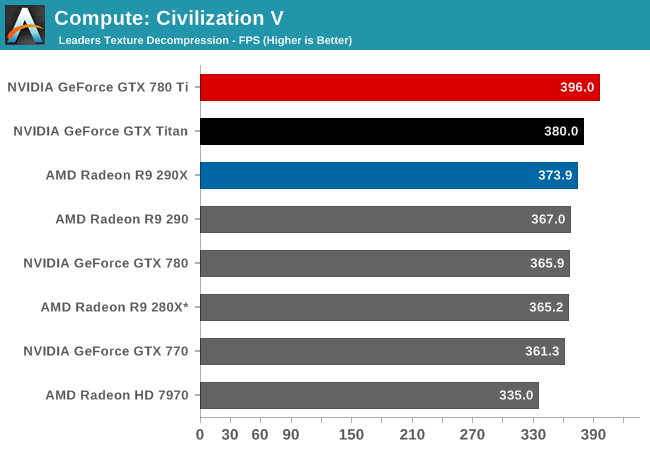
Even though we’re largely CPU bound by this point, GTX 780 Ti manages to get a bit more out of Civilization V’s texture decode routine, pushing it to the top of the charts and ahead of both GTX Titan and 290X.
Our next benchmark is LuxMark2.0, the official benchmark of SmallLuxGPU 2.0. SmallLuxGPU is an OpenCL accelerated ray tracer that is part of the larger LuxRender suite. Ray tracing has become a stronghold for GPUs in recent years as ray tracing maps well to GPU pipelines, allowing artists to render scenes much more quickly than with CPUs alone.
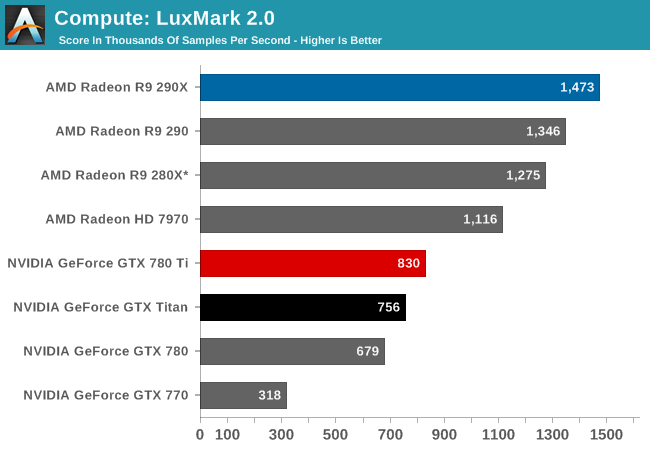
With LuxMark NVIDIA’s ray tracing performance sees further improvements due to the additional compute resources at hand. But NVIDIA still doesn’t fare well here, with the GTX 780 Ti falling behind all of our AMD cards in this test.
Our 3rd compute benchmark is Sony Vegas Pro 12, an OpenGL and OpenCL video editing and authoring package. Vegas can use GPUs in a few different ways, the primary uses being to accelerate the video effects and compositing process itself, and in the video encoding step. With video encoding being increasingly offloaded to dedicated DSPs these days we’re focusing on the editing and compositing process, rendering to a low CPU overhead format (XDCAM EX). This specific test comes from Sony, and measures how long it takes to render a video.

Like LuxMark, GTX 780 Ti once again improves on its predecessors. But it’s not enough to make up for AMD’s innate performance advantage in this benchmark, leading to GTX 780 Ti trailing all of the AMD cards.
Our 4th benchmark set comes from CLBenchmark 1.1. CLBenchmark contains a number of subtests; we’re focusing on the most practical of them, the computer vision test and the fluid simulation test. The former being a useful proxy for computer imaging tasks where systems are required to parse images and identify features (e.g. humans), while fluid simulations are common in professional graphics work and games alike.
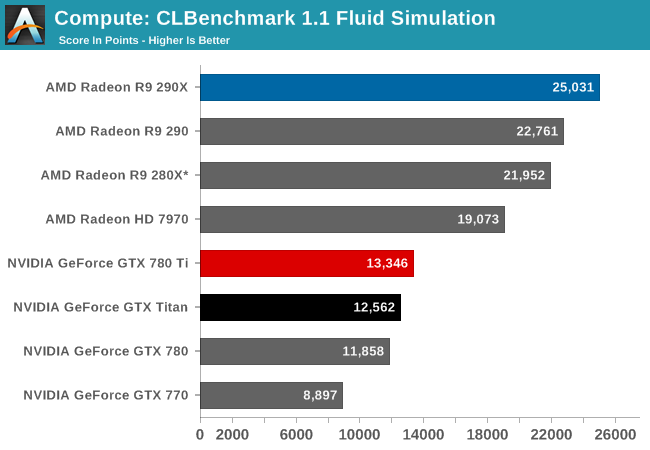
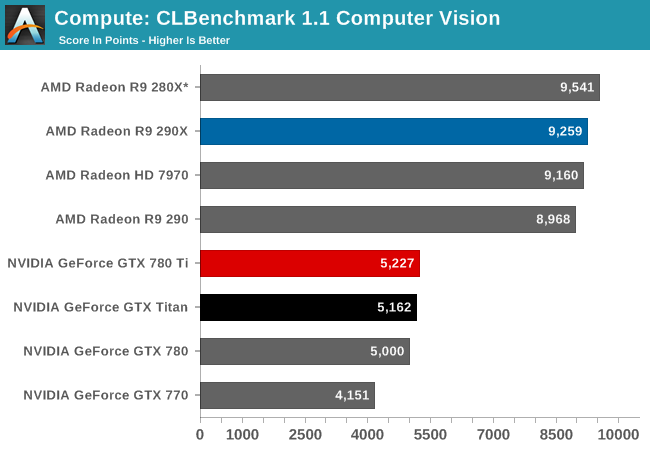
CLBenchmark continues to be the same story. GTX 780 Ti improves on NVIDIA’s performance to become their fastest single precision card, but it still falls short of every AMD card in these tests.
Moving on, our 5th compute benchmark is FAHBench, the official Folding @ Home benchmark. Folding @ Home is the popular Stanford-backed research and distributed computing initiative that has work distributed to millions of volunteer computers over the internet, each of which is responsible for a tiny slice of a protein folding simulation. FAHBench can test both single precision and double precision floating point performance, with single precision being the most useful metric for most consumer cards due to their low double precision performance. Each precision has two modes, explicit and implicit, the difference being whether water atoms are included in the simulation, which adds quite a bit of work and overhead. This is another OpenCL test, as Folding @ Home has moved exclusively to OpenCL this year with FAHCore 17.

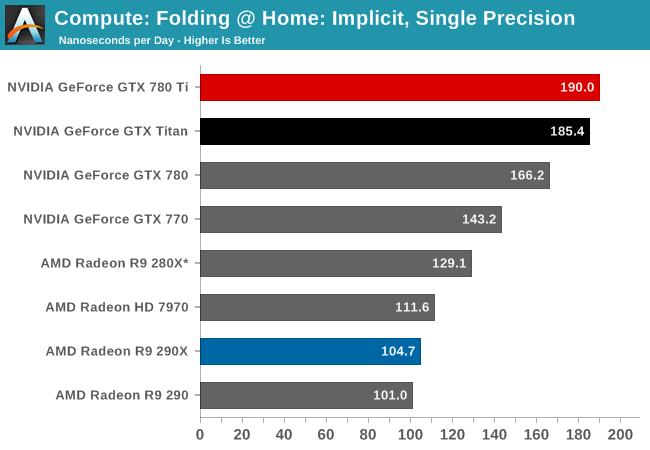
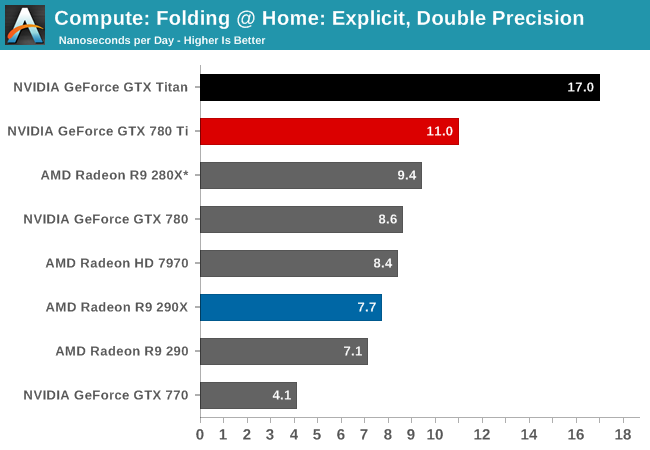
Finally with Folding@Home we see the GTX 780 Ti once again take the top spot. In the single precision tests the GTX 780 further extends NVIDIA’s lead, beating GTX Titan by anywhere between a few percent to over ten percent depending on which specific test we’re looking at. However even with GTX 780 Ti’s general performance increase, in the double precision test it won’t overcome the innate double precision performance deficit it faces versus GTX Titan. When it comes to double precision compute, Titan remains king.
Wrapping things up, our final compute benchmark is an in-house project developed by our very own Dr. Ian Cutress. SystemCompute is our first C++ AMP benchmark, utilizing Microsoft’s simple C++ extensions to allow the easy use of GPU computing in C++ programs. SystemCompute in turn is a collection of benchmarks for several different fundamental compute algorithms, as described in this previous article, with the final score represented in points. DirectCompute is the compute backend for C++ AMP on Windows, so this forms our other DirectCompute test.
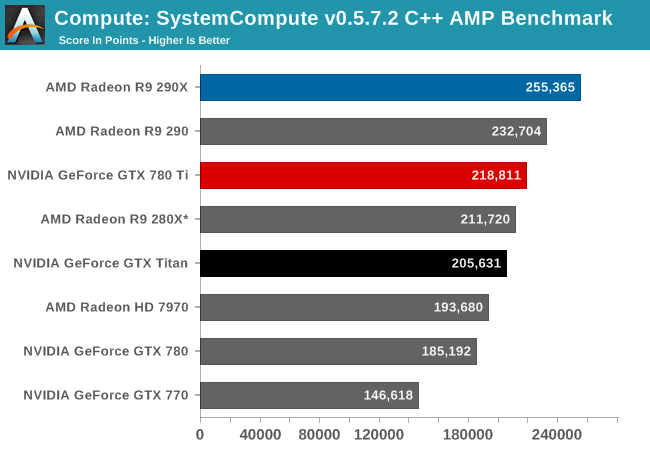
Last, in our C++ AMP benchmark we see the GTX 780 Ti take the top spot for an NVIDIA card, but like so many of our earlier compute tests it will come up short versus AMD’s best cards. This isn’t quite as lopsided as some of our other tests, however GTX 780 Ti is stuck competing with the 280X while the 290 and 290X easily outperform NVIDIA’s new flagship.










302 Comments
View All Comments
Kamus - Thursday, November 7, 2013 - link
I wouldn't buy that aftermarket cooler just yet.... I was about to buy one when I read that it's not cooling the VRM properly. Some guy bought 2 of them for his crossfire setup and started hearing whine from both cards. He concluded it was the crappy heatsinks that they provide for the VRM aren't up to the task.The VRM was exceeding 100 degrees. This resulted in games crashing and the loud whine I mentioned earlier. In the end, he put the regular AMD heatsinks back on, and that fixed the problem. Then he sold both cards and now he says he might just get regular 290's when they ship with custom coolers. Which isn't a bad idea at all, since those will probably outperform the reference 290x easily, for a lot less cash.
Margalus - Friday, November 8, 2013 - link
so in other words, you have to spend another $100 for an aftermarket cooler to make the 290 a reasonable card?milli - Thursday, November 7, 2013 - link
All you need is an Accelero Xtreme III. It proves that as soon as companies like HIS release better versions, the R9 cards will be silent, fast and cheap. I have a HIS HD 7950, a supposed loud card, that is completely silent.http://www.computerbase.de/artikel/grafikkarten/20...
Sivar - Thursday, November 7, 2013 - link
I gather from the link that you natively speak German. Please note that, in English, "silent" means "absolutely no sound". I think the word you are looking for is "quiet". :)HisDivineOrder - Thursday, November 7, 2013 - link
True, when custom cooled cards come out, that'll be great. None are announced and as far as I know no one's seen any. So you're waving your hands right now and saying, "When better cards come out, they'll be better!"You're talking about unannounced things you expect will come and save the day. I could easily say that overclocked variants of the 780 Ti are going to come and make everything better. Or that the GHZ editions of the 780 (non-Ti) are going to show up and magically make the price point logical again.
But you know what? I'm waiting until what I think MIGHT happen actually DOES happen. Rather than daydreaming about HIS coolers or MSI coolers or Gigabyte Windforce coolers on the R9 series when they haven't shown anyone a sign of such a card yet. Are they coming? Sure, yeah, someday. Are they coming in 2013?
...No one's seen one yet. Hell, there's more evidence of GHZ versions of the standard 780 than there are of custom-cooled R9 290/290x cards...
OverclockedCeleron - Thursday, November 7, 2013 - link
... and your point is? You are happy with a 700-dollar-card, then good for you. I was only speaking up because I have noticed a significant rise of anti-AMD trolls (i.e. Nvidia PR Reps). Just read the first comment to this article and tell me you don't see anything wrong with it.So you like logic and you think you got it all sorted? Well, how about this: Try to judge the silicon and not the fan, i.e., install equally superior GPU air-based coolers, and then Overclock each card to the maximum stable overclock, and re-run the benchmarks. I know who will win, but I am not here to preach or daydream like you said.
The point is, just because I realize the *actual* and *real* potential of something doesn't mean I am a daydreamer, it just means I appreciate that piece of silicon (i.e. R290X) and I realize that it is superior to the 780 Ti if it was not for that cheap heatsink.
TheJian - Thursday, November 7, 2013 - link
You're wrong unless you're saying NV will win after both are equipped with equal cooling and also, Superclocked 780TI has already been announced :)http://videocardz.com/47777/evga-launches-geforce-...
https://www.evga.com/articles/00795/#2884
1006/1072 out of the box. Dual classified has yet to be clocked. But would have to be faster than ACX version and they already have announce the water block model :)
03G-P4-2889-KR GTX 780 Ti Dual Classified w/ EVGA Hydro Copper
Currently you void your warranty pulling this on 290x or 290 right? Sure seems like OEM's have no trouble modding NV. I'm guessing AMD has to sort out this variance stuff before the OEM's can jump on board.
Realizing AMD is getting beaten doesn't make you an NV PR troll...LOL. This doesn't mean AMD's silicon is junk, just it's beaten. I for one am glad they released it forcing NV's full SMX hand. That means we can all look forward to even better 20nm chips as they now have a much higher bar to beat on both sides. I own a radeon 5850 BTW, because I realized it was the best silicon when I bought it (8800GT before that). I go wherever the SILICON/features tells me. The 8800GT is still serving my dad's pc from 2007 (over 6yrs old!). I'm wondering if these 95C chips can make it that long ;) My 5850 will be serving him the second I get my hands on 20nm maxwell (if only for gsync unless NV's chip totally sucks).
Galidou - Thursday, November 7, 2013 - link
No need to be a genius to KNOW that the custom cooled cards will be WORLDS above this even if they are not out. If you did not realise how crappy that cooler is, it was crappy for 7970 cards and it's the sAme... Comon, a little more than 90 IQ is necessary to find out about that...Toxicsix - Thursday, November 7, 2013 - link
More for less you say... Let's look at that. The 290X excels at 4K gaming and that's what AMD keeps cramming down our throat, how superior there product is at the highest resolutions. So If your looking at price performance you need to pair that 290X with a 4K display. Now let's look at some simple numbers shall we. 290X $5-600 + 4K Display $3k+ so your sitting at about $3500+ to get that top end performance. On the other hand you can spend $700 on a 780 Ti and pair it with an amazing 1080p monitor for well under 1k and the 780ti will stop all over Your 290X. Now your probably thinking that this isn't a "fair" comparison but you have to consider that the resolution is where these companies are going to try convince you that there card is superior. As it stands the 780 Ti is the King of 1080p gaming and it pisses me off big time that anadtech didn't even include 1080p benchmarks as this is where the majority of gamers are. If you want the best gameplay possible I would recommend getting the sweetest 1080p monitor you can find that will give you great refresh rates, low input lag and 3D capabilities if that's your thing and pair it with the fastest 1080p gaming card you can find which is now Nvidia's 780Ti. AMD has a great card in the 290X but we can't just look at price/performance based on the card alone we have to consider what were playing it into and look at the complete package as one.Fan_Atic - Thursday, November 7, 2013 - link
I hate to say it but most of your points are completely moot. The reason no one runs 1080p benchmarks in these reviews is that it doesn't stress a modern card. Anything above the $200 price point can pull 60 FPS at max settings any more. No one in their right mind would spend $700 for a graphics card to play at 1080p when a $250 can provide a 60fps experience with the same settings. 1440p 1600p and 4k are the only things that remotely stress modern mid to high end graphics cards.